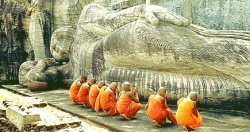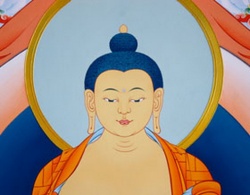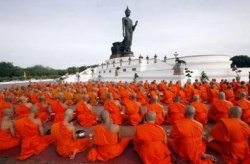The Role and Impact of Vessantara Jātaka in the Lao PDR by Ven Sayadej Vongsopha
Laos is one of the Buddhist countries in Southeast Asia where Buddhism has firmly taken root as well as in her neighboring countries such as, Thailand, Burma, Cambodia, and Vietnam and so on. While the exact dates of the introduction of Buddhism to Laos, as in the case of her neighbors, are of a matter of debate.
However, according to Nangsue nithan Urangkhathat, the “Chronicle of the Stupas of the Breast-Bone Relic of the Buddha” or the chronicle of Vientiane which is related to the stories of Nāga, recounting that, once Buddhism started spreading through the Mekong Valley where the Buddha ever traveled through this area and predicted that this land would be civilized and Buddhism would flourish here. And afterwards, after the Buddha entered into parinibbāna for 8 years, 7 months and 15 days or in the 8th century B.E, the Venerable Mahā Kassapa Thera together with 500 monks (there must have been 5 monks) traveled to this land and brought with them the breast bone relics of the Buddha from India to be enshrined in Phoukampa, the Kingdom of Sikhotabong, the present Phra Thatpranom stupa.
In the 3rd century B.E, during the time of Emperor Asoka, who sent the groups of missionary monks to Indochina peninsula including Myanmar, Thailand, Cambodia, Indonesia and Laos. This group was conducted by the two arahats the Venerable Sona and Uttara.
Until the time of Burichan who was enthroned in A.D. 475, there were also two arahats from India, the Venerable Mahā Putthavongsa and the Venerable Mahā Sassadi who served Buddhism at that time. The Venerable Mahā Putthavongsa lived in Putthavongsa Paluang or the present Wat Sok Paluang and the Venerable Mahā Sassadi lived in Wat Thepnimit(Thatfoun) in Vientiane. This means that the Buddhism has flourished in Laos since the time of Asoka and earlier than that.
According to Andrea Matles Savada, during the 7th century A.D, Tantric Buddhism was also introduced into Laos from the Kingdom of Nanchao and around at the same time, Theravada Buddhism was also introduced into Laos around 7th or 8th century by Mon Buddhist monks. And during the 11th and 12th century A.D, Khmer rulers took control of Muangsua, the historical region of the Kingdom of Luang Prabang in the northern Laos then Mahayana Buddhism was replaced by Theravada Buddhism.
And up to the 14th century A.D, Theravada Buddhism was introduced again from Cambodia in form of Sri Lankan Theravada tradition by King Fa Ngoum. This time was the most official phase which has been professed and practiced since then and through the ebbs and flows of the history, Buddhism sometimes has encountered with difficulties, it never wholly disappeared from the country, but survived and flourished up to the present.
Introduction to Vessantara Jātaka
Now, after a short introduction to Buddhism in Laos, we come to know about Vessantara Jātaka. It is a Buddhist story describing the former life of the Buddha when he was born as a Bodhisattva- a Buddha-to-be named Vessantara. The story is included in the ten collections of Jātakas which are the final rounds of rebirths of the Bodhisattva who cultivated pārami or perfection for countless circles of rebirths. It is a famous Jātaka which has special emphasis on the generosity perfection or Dānapāramī. The story was told by the Buddha Himself while dwelling at Nigrodāram, Kapilavatthu during His early visit His father, King Suddhodana and royal cousins after He attained the Supreme Enlightenment. When visiting them, the celestial rain was down pouring and this astonished the people so the Buddha told that the rain did not occur only this time but ever happened when He was born as Vessantara Bodhisattva.
Vessantara Jātaka is really well-known in Laos and in neighboring countries; its origin is in Pāḷi but later it was translated into Lao in both prose and poetic styles. In Laos, the preaching ceremony of Vessantara is annually organized which is called as Boun Praveth or Boun Mahāchart in Lao or Vessantaradesanā in Pāḷi. Because it was rendered into Lao poems so that it produces more literary values and increases conviction to audience who fond of the melodic styles, especially, the elder people, so it is so captivated and enthralled when listening and considered as classic and high literary values, the masterpieces of Laos out of other three that are, Sinxay epic, Thao Heuang Thao Cheuang epic and Sane leup pra soun or undeletable message. However, its rendition into poem is unknown who was the author or translator, but there are reliably possible sources. According to Mahasila Viravong, in his introduction to Vessantara Mahājati, it was rendered into poems for the first time in 1482 A.D in the reign of King Paya la Saentaiphouvanarth which was the same time as the reign of King Praboromtrailokanarth, Ayutthaya period. Later, it was revised in 1620 A.D. in the reign of King Voravongsa Dhammikaraj, the son of King Saysethathiraj’s aunt which was in the time of King Chong Dham of Ayutthaya.
When translating Vessantara Jātaka into Lao poems for the first time, there were many prominent monks who were well-versed in Pāḷi, namely:
- 1.Venerable Phra Khamphi Mahathera, the abbot of Wat Keo, the supreme patriarch;
- 2. Venerable Phra Mahā Thepluang, the abbot of Wat Manorom, who was the Dhammasena(comparing to the right chief disciple of the Buddha,Venerable Sariputta);
- 3.Venerable Phra Dhammavongsa Thera, posited as Sanghasena (comparing to the left chief disciple of the Buddha, Venerable Mahā Mogallana)
Venerable Phramahā Thepluang had longevity and lived up to the reign of King Visunnaraj. He composed Nithane Khunburom (the story of the King Khounburom) in the contemporary period of Venerable Phramahā Mongkol Siddhi in 1504 A.D and Ajahn Dhammajunlanenoi-a lay Buddhist scholar who was appointed King Visunnaraj to teach Pāḷi and Sanskrit for monks and novices in Luang Prabang. And at that time, Somdet Phra Sangharāja Visunmahāvihāradipati Srisattanaganāhut, the supreme patriarch, who translated Pañca Tantara Nidāna Pakaraṇa from Pāḷi into Lao. Therefore, Vessantara Jātaka in Lao poetic version presumed to have translated at that time. In addition, due to Laos shared the same Buddhist tradition as her neighboring countries, especially Thailand during Ayutthaya period; monks may have learned and exchanged knowledge from each other. However, when it was translated into Laos, it remained Pāḷi words followed by Lao words or expression; it is called nissaya which is the form of Pāḷi translation that is left a word of Pāḷi and begin translating from that word but in expression and events related to the word, for instance, pattova, comes in the morning, she hurries to go into the forest, seeking fruits and so on, this is the identity of Lao ancient Tipitaka translation as it remains until today. Since then, Vessantara Jātaka has many poetic versions in different localities of Laos for instance, in Luang Prabang, Savannakhet and Champassak.
And today some of Buddhist scholars also have produced new version of poems of Vessantara Jātaka. One of them is Ajahn Bounteum Sibounheuang, the well-known lay teacher for he is expert at Vessantara Jātaka, poet, Dhamma teacher, and also a teacher at Sangha College. He set up own family library opening for general people, monks and novices, providing Dhamma study, life skills, and the most interesting programme is to learn how to give Vessantara Jātaka sermon. There are many monks and novices have joined the programme. In addition, He has produced daily radio programme “Dhamma at Dawn” to broadcast Dhamma talk and sometimes he gives Vessantaradesanā as per request. The family library is really useful for monks and novices to learn with him so that they can help to preserve the tradition of Vessanataradesanā and to promote Buddhism. Apart from this, Vessantara Jātaka is also included in the curriculum of public schools, especially in Lao literature.
Its Role and Impact on Lao literature and Society
As Vessantara Jātaka was composed in poems, it carries significant influence in Lao literature and Lao culture. The ceremony of Vessantaradesanā is a big event, annually organized and which is included in Hid Sip Song (the traditional ceremony organized in each month of the year) originated in the time of King Fa gnoum in 14th century B.C. It is different from other ceremonies because it takes a whole day to finish, therefore, people in the whole village have to work to gather in harmony, to prepare for the event for instance, cleaning the temple ground, arranging the ceremonial venue. Villagers are appointed to serve monks and novices who are invited from other different temples to preach in the ceremony. In this event, everyone is responsible for it, ranging from an abbot, the chief of village to general villagers. This creates the harmony in a village community.
Vessantaradesanā is not a mere festivity, but it plays a significant role on educating people. It is an opportunity for them to learn the Dhamma and bring it into practice in their daily life in order to live in harmony and develop generosity in the village community. In some temples in the countryside, elder people can remember even Pāḷi gāthā or verses, and if monks or novices skip any parts or verses, they will be reminded. In order to be fluent in reading Vessantara Jātaka in Tham alphabets from palm leaf manuscript, monks and novices need to study and rehearse before the ceremony takes place and within a week they can master of it. By doing so, this is really useful for the preservation of palm leaf manuscript and the Buddha’s teachings.
Apart from this, Vessantara Jātaka contains nine literary tones or tastes, which is considered the most complete factors of literature, while other Lao literature works are not, there are:
- 1.Rati: Taste of love, satisfaction
- 2.Hansa : Taste of happiness, entertaining
- 3.Soka: Taste of sorrow,
- 4.Koda: Taste of revenge,
- 5.Utsaha: Taste of perseverance,
- 6.Bhaya: Taste of suffering or fear,
- 7.Jikuccha: Taste of disgusting, boredom,
- 8.Vimuhaya: Taste of amazement, astonishing
- 9.Sama: Taste of tranquility
This mellifluously impresses audiences especially when monks and novices preach in special intonation of melodramatic sound. This is a charm of Vessantara Jātaka that contributes to Lao literature. In reality, it does not only entertain people but it also convinces and encourages them to increase merits particularly by offering Dāna or giving, the practice of generosity perfection. When giving Dāna, most people wish to be reborn in the heavenly realm and have aspirations to meet the Metteya, the future Buddha. This is also influenced by the story of Venerable Malayadeva who travelled to heaven and hells and reported his experience to people in the human world. The Mettaya told Malaya Thera that if someone has a wish to be reborn in the time of him, he must listen to the Vessantara Jātaka recitation a whole day in full of 1000 Pāḷi gathā, he will get benefits from this and will not reborn as a purgatory beings, but will travel in the saṃsara with the save boat.
Besides, Vessantaradesanā is an annual ceremony which is recorded in Hid Sip Song of Laos, it also influences on Lao literature, arts, politics and so on. In the ceremony, the painting of Vessantara Jātaka is ready onto the cloths depicting the whole story. And mural paintings of Vessantara can be found nearly every temple in Laos.
In addition, the characters in the Jātaka have become to talks of people, for example, when someone is really greed and craving he will be compared to Jūsaka, the Brahmin who beg for the Kaṇhājina and Jāli. If someone is really generous and kind, he will be compared to Vessantara Bodhisattva, and if someone is really a good wife, she will be compared to Maddī, the Bodhisattva’s queen, and if a woman when giving dāna to monks makes a unwilling face, she will be remained to make a smiling face otherwise she will have an old husband like Jūjaka. And if someone is not a good wife, who commits sexual misconduct, will be compared to Amittatāpanā, the Jūjaka’s wife.
From my personal analysis, if comparing to the Buddha’s teachings, the characters in Vessantara Jātaka representing metaphorical meanings of Dhamma itself, for instance, Vessantara Bodhisattva indicates wholesomeness( kusala Dhamma), Jūsaka, the Brahmin represents unwholesomeness(akusala Dhamma). In addition, its literary tones conveying complete senses of normal human behaviors which can be compared to daily life, for instance, the sense of tranquility conveying the meaning of calmness and peacefulness, the sense of sorrow representing the meaning of worldly concerns which one can learn and observe from this Jātaka applying it as a mirror of life.
Besides, the poetic version of the Vessantara Jātaka is divided into 13 sections and used as a part of casting luck in some temples. People will use this as the way of prediction; they can read their fortunes themselves without any helps from monks. This is to prove that the Vessantara Jātaka is really influenced in Lao society.
The cause of Vessantaradesanā
As mentioned above, the ceremony of Vessantaradesanā is annually organized because it is influenced by the Malaya Sutta, which is a post-canonical text; the author of the sutta is unknown. Another reason is to maintain Buddhism from the extinction based on the Buddha’s prediction. According to His prediction, Buddhism will gradually vanish after it has reached the 2000 years and there will be very few monks who are well-versed in the Tipitaka. There are five kinds of disappearance of Buddhism as follows:
- 1.Pariyatti antaradāra: The disappearance of pariyatti studies(theoretical studies),
- 2.Paṭipatti antaradāra: The disappearance of paṭipatti (the practice),
- 3.Paṭiveda antaradāra: The disappearance of paṭiveda( the real experience)
- 4.Sangha antaradāra: The disappearance of the Sangha,
- 5.Dhātu antaradara: The disappearance of dhātu( the Buddha’s relics)
Discerning the causes of disappearance of Buddhasāsana from the prediction, the Lao ancient Buddhist scholars made an effort to prevent it from vanishing by composing and translating the Vessantara Jātaka in various versions and made it easy in both prose and poems. The poetic version often brings melodramatic expression which it really attracts the audiences. Therefore, the Vessantaradesanā is remained until today.
Another reason why people like the Vessantara Jātaka because Vessantara Bodhisattva is a righteous, generous and kind. He has the ten qualities of the righteous king. Therefore, he is a role model of all kinds of people and they have strong conviction to listen to Vessantaradesanā because of the Bodhisattva is the present Buddha.
Skepticism in Vessantara Bodhisattva
However, there are some doubts in the generosity of King Vessantara when he gave all everything to the poor, even his son, daughter, wife and if someone wanted his life he also would give it to them. Some may criticize that giving a son, daughter and wife to others is against human rights. Generally, common people are quite right, but there are three levels of cultivating generosity perfection:
- 1.Dānaparami: Cultivating the generosity perfection in a normal level;
- 2.Dānaupapāramī: Cultivating the generosity perfection in a higher level;
- 3.Dānaparamaṭthapāramī: Cultivating the generosity perfection in the highest level;
To cultivate normal generosity perfection, one may donate food, clothes, accommodation, medicines in general; to cultivate a higher level of generosity perfection, one has to do more dedicating and sacrificing themselves. But the highest level is to give something that common people cannot do, for example, Vessantara Bodhisattva gave his daughter, son and his wife to Jūsaka, the Brahmin, which is the tradition of all Buddhas in order to fulfill the dāna pāramī perfection.
Conclusion
Vessantara Jātaka has really influenced on Lao people. It is one of the four masterpieces of Lao literature. It reflects every aspect of daily life and becomes a part of Lao traditional and culture as people always refer to the circumstances and characters in the Jātaka as their role models. The annual ceremony of Vessantara Jātaka recitation really reminds people to live in harmony, to work together, to become generous people. This brings happiness and peace to the village community and to the many.
Even though Vessantara Jātaka is the former story about the Gautama Buddha who is the present Buddha, it is annually recited in order to maintain the Lao tradition and culture as well as to prevent Buddhism from the five kinds of disappearances as mentioned above. Another reason is that people believe to be reborn as heavenly realms and to be in the presence of the Mettaiya, the future Buddha. However, this tradition needs to promote more and more.
REFERENCES
- Anguttara Nikaya, Mahachulalongkorn Tipitaka.
- Goonalilake, Hema, Re-visiting Sri Lanka-Myanmar Historical Links, Private Circulation only, 2009.
- Sila Viravong,Mahā.Vessantara Jātaka, Sor Dhammaphakdy, Bangkok: 1957. An Autobiography of Mahā Sila Viravong.Vientiane: State Printing Press, 1990.
- Borsaengkham Vongdara, Buakeo Chaleunlangsy. Lao Literature.Vientiane: Educational State Enterprise, 1987.
- James Chamberlain. Thao Hung or Cheuang: A Tai Epic Poem, Mon Khmer Studies, 18-19:14-34.
- Kidaeng Phonekaseumsouk. Phra Vethsandorn(Champassak version), Vientiane: published by The Association of Social Research and Oratory Skills Promotion, 2007.
- National Library of Laos. The Literary Heritage of Laos: Preservation, Dissemination and Research Perspectives.Vientiane: Manthatulat Printing House, 2005.
- Phra Lakham Vajiravisuddhikhoun(Sadhu Khamchan Viracitta Thera), Desanā Mahāchart(Vessantara Jātaka), Bangkok: Duantula Printing Press, Donemuang, 2007.
- Phramahā Boonthan Anantho(Phala). Analytical study of Vessantara Jātaka: A case study of Dānapāramī. Bangkok: A thesis submitted Mahachulalongkorn Buddhist University, 1997.
- Phramahā Somchart Nandadhammiko(Busanare). A study of value of the Mahājāti Preaching in Lanna. Bangkokg: A thesis submitted to Mahachulalongkorn Buddhist University, 2006.
Source
Author: Ven Sayadej Vongsopha
buddhismandaustralia.com




